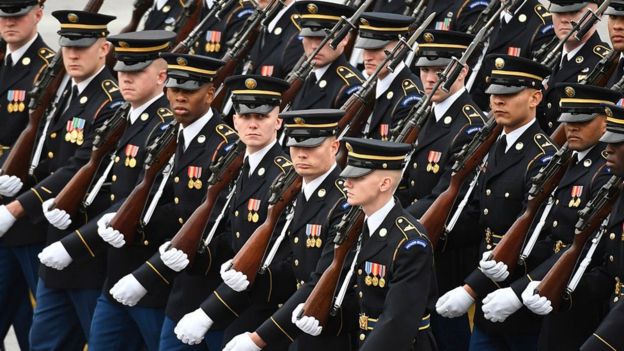US President Donald Trump is seeking to boost defence spending by 10% in his proposed budget plan for 2018.
The blueprint will increase defence spending by $54bn (£43bn) but seeks to recoup that sum through deep cuts elsewhere, including to foreign aid.
Mr Trump’s plan leaves large welfare programmes untouched, despite Republican calls for reform.
The president has consulted government agencies about his plans and will present his budget to Congress in May.
Between now and then, he needs to identify where the agencies can make savings and work out what he does with tax reform.
Republican John McCain said the $603bn defence budget – which was outlined by White House officials – would be insufficient.
Speaking at the White House during a meeting with state governors on Monday morning, Mr Trump said: “We’re going to do more with less and make the government lean and accountable.”
The president, who vowed to increase military spending and preserve welfare programmes during his campaign, said the budget will focus on “military, safety, economic development”.
“It will include an historic increase in defence spending to rebuild the depleted military of the United States of America at a time we most need it,” he said.
Military spending has declined in recent years due to budgetary battles in Congress that led to a spending freeze on defence.
However, it is still not uncommon for Congress to approve procurement of tanks, aircraft and ships that the Pentagon says it doesn’t even need.
Mr Trump’s proposal would return the US closer to wartime spending.
He also said he would spend “big” on infrastructure like roads and rails, but he has not yet revealed his tax plans.
Mr Trump pledged to cut taxes during his presidential campaign, which would probably add to the national debt, a figure that could hit $20 trillion on his watch.
Analysis – Anthony Zurcher, BBC News North America Reporter
Keeping both of his campaign promises – boosting the military and protecting welfare – will put the president in a tough bind.
If he wants to boost the defence budget by $54bn without adding to the deficit, that money will have to come from somewhere – and mandatory spending on welfare and debt interest takes nearly 70% of the budget off the table.
Early reports are that the Environmental Protection Agency is facing sharp cuts, but its total annual budget is just over $8bn – a drop in the bucket.
The State Department has also been singled out as a source for the needed funds, and its $50bn annually (including $22bn in direct aid) makes it a fatter target.
The lion’s share of humanitarian assistance goes to rebuilding efforts in Afghanistan and Aids treatment in Sub-Saharan Africa, however, which will be difficult to touch. Also unlikely to get the axe is military support, dominated by $3.1bn annually to Israel.
There’s a reason the Trump administration announced the military budget number before revealing where the money will come from. Spending is easy; cutting is hard.
BBC
 Q FM Africa's Modern Radio
Q FM Africa's Modern Radio
